|
| To Search This Site Enter Key Words Into Text Field On The Right and Hit The Search Button |
|
|
Titanic Books 2003, The Year in Review.
Titanic remained a modestly popular subject in 2003, although the total number of books printed was down significantly from the previous year by almost 30%. Still just over 20 books were printed on the disaster in 2003, ranging widely in subject matter from the fascinating and ground breaking, to the whimsical and quirky.
The Wreck Takes Center Stage.
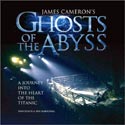 |
By far the most important titles released were related to exploration of the wreck at the bottom of the Atlantic. One of the books released early in 2003 was Don Lynch and Ken Marschall’s awesome book Ghosts of the Abyss. A Journey Into the Heart of the Titanic, recounting their experiences on James Cameron’s expedition to film the interior of the Titanic for his IMAX style film. This book is a treasure, not only combining the talents of some of the biggest names in Titanic circles, but also revealing images of the ship that have not been seen by human eyes since she sank over 90 years ago. This was the best book, by far to be released in 2003 and won my Titanic Book of the Year Award© for the year. |
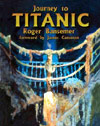 |
In the Fall, a very different kind of wreck exploration book came out. This one was by accomplished author/artist Roger Bansemer, called Journey to Titanic. Bansemer relates a trip to the wreck in his distinctive art and writing style focusing on the outsider’s experience of such an adventure. Actual Titanic content is minimal, but the author captures, perhaps better than anyone before, what it is like to join an expedition to the wreck, sail with the crew, meet the people on board, and experience a dive to the most famous of shipwrecks. |
Rounding out the books about the wreck is one with the imposing title Draft Agreement Concerning the Shipwrecked Vessel RMS Titanic. Miscellaneous Series 2003. This one was printed by the British government’s publication branch, the Stationary Office. I don’t know exactly what this one is about, but surmise it relates to the international legislation that countries are attempting to ratify to recognize the wreck as a memorial, giving it special protection status.
History and Research Topics Continue to Unearth New Information.
The story of the Titanic disaster continues to fascinate people with the questions of what really happened? How did it happen? Why did it happen? Original research continues to be published, a lot of it through private channels and small press publishers.
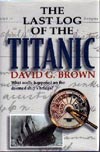 |
Although originally published in 2000, David Brown’s book The Last Log of the Titanic was finally released in a soft cover edition in 2003. This groundbreaking analysis of what really happened the night Titanic sank remains one of the best books on the subject ever printed. Brown’s theories have evolved since the hardcover edition, but unfortunately he was not given the chance to update the book for the paperback release. Still, this is one of the must read books and it is great to see it available in a less expensive soft cover edition which will enable it to reach a wider audience. |
Most of the rest of the year’s nonfiction titles were printed by small presses or were printed privately by the authors themselves. Senan Molony continues to be the most prolific of writers, self publishing three books in 2003, two of which will be covered here, the other a bit further along.
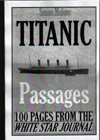 |
Molony’s first book was Titanic Passages. Editor’s Selection of 100 Pages from the White Star Journal. This is a potpourri of articles he wrote over the past few years while editor of the Irish Titanic Historical Society’s quarterly magazine, the White Star Journal. In all there are about 65 articles on a whole spectrum of topics as diverse as a piece about Captain Rostron’s celebrated sighting of a sea serpent to the discovery of a photograph believed to be the very last one ever taken of Titanic. |
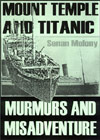 |
At the end of the year he self published a 44 page research article on Mount Temple, one of the ships that responded to Titanic’s distress calls, but never played a significant role. Called Mount Temple and Titanic: Murmurs and Misadventure, this book brings together all the news reports of passengers and crew who were aboard the ship. It also includes the testimony of the ship’s captain and Marconi operator at both the American and British inquiries.
More than just a compilation though, Molony once again puts his professional talents as a journalistic reporter to the case with his insightful commentary. Could Mount Temple have done more to aid Titanic? He attempts to answer that question by examining the verbal evidence to determine what may or may not have really happened on Mount Temple that night.
|
Another book was published by the Belfast Industrial Heritage, Ltd. called The Titanic, A Short Pictorial History. Unfortunately several requests through the Internet for information about this book were never answered, so I can’t say anything further about this one.
Rounding out this section is the latest edition of Brian Ticehurst’s Titanic’s Memorials Worldwide: Where They are Located. Ticehurst has been constantly expanding and updating this work for years. This latest version covers an incredible 1014 memorials in over 29 countries, and with 926 people named.
Books for Children Are as Popular as Ever.
It has always struck me as odd that Titanic would be such a popular subject for young readers. Yet the number of books aimed at this market is huge, and continued to be a strong one in 2003.
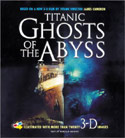 |
Don Lynch & Ken Marschall’s book, Ghosts of the Abyss, mentioned at the beginning of this article was also released in a version for young readers. The children’s book was written by Mireille Majoor and Ken Marschall, called Titanic: Ghosts of the Abyss. It was written for the 9 to 12 age group. What sets this book apart from the adult book is that it comes with 3-D glasses and more than 35 3-D images that children, and yes grownups too, are going to love. |
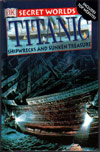 |
John Malam wrote an anthology of undersea exploration for young readers in the 9 to 12 age group in a book called Titanic, Shipwrecks and Sunken Treasure. It came out as part of a series called Secret Worlds in the U.S. and Mega Bites in the U.K. It is a fun selection of chapters on various shipwrecks, treasure hunting and underwater exploration. Besides Titanic, other specific ships covered include the Geldermalsen, and the Vasa. There is a chapter on other lost liners and one on wrecked warships. Beautifully color illustrations throughout augment the text, although sometimes the text on top of the illustrated backgrounds can be a bit hard to read. |
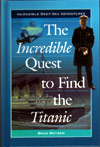 |
Brad Matsen wrote a book on the discovery of the Titanic wreck called The Incredible Quest to Find the Titanic. This book was a volume in the Incredible Deep-Sea Adventures series. It is aimed at the same age group as the two already mentioned above. This book combines a brief history of the disaster with the search to find the wreck. Kudos go to Matsen for remembering that Dr. Ballard & Jean-Louis Michel were co-discoverers of the lost ship. Nicely color illustrated in the text throughout. |
Another title for young adults was by Paul Shipton called Titanic Survivor: The Story of Harold Bride. It is a title in the Oxford Reading Tree series and is focused on attracting reluctant young readers, particularly boys.
Titanic fiction for children was not ignored this year either. Corrine Brown wrote a book called The Stowaway on the Titanic. It is about two 12 year old orphans, one black and one white, whose friendship is tested both by adult hostilities to their presence as well as the ultimate test of surviving the sinking. Another fictional account is by Bernard Ryan, Jr. called Tyler’s Titanic. This latter one was written for the four to eight age group.
Titanic Titanic Everywhere.
It’s hard to believe that there was a time when it was perfectly acceptable to write a maritime anthology and not mention the Titanic even once. That was back before the wreck was discovered. It certainly isn’t true anymore, Titanic being almost a prerequisite for any anthology remotely touching on the subject of ocean liners, shipwrecks or disasters.
 |
By far the best shipwreck anthology of the year was written by William H. Flayhart, III, called Perils of the Atlantic: Steamship Disasters, 1850 to the Present. Flayhart does a better job than most anthology writers of getting his facts right. The other bonus is the interesting selection of events he has chosen to cover. He includes all the better known disasters, like the Arctic, the Atlantic, the Republic, Titanic, Empress of Ireland, Lusitania, Morro Castle, and the Andrea Doria. But he goes on to cover many lesser known events, some that ended in tragedy and others where disaster was narrowly averted by the heroic actions of crew and passengers. In all, 21 maritime mishaps are detailed. |
Another disaster anthology that includes Titanic is Cormac O’Brien’s The Daily Disaster. Real Life Stories of 30 Amazing Disasters. It is a look at a chronological series of disasters starting with the Chicago Fire in 1871 and ending with the Venezuelan mudslides of 1999.
Going even further afield from disaster books, there was this interesting book by George Burden & Dorothy Grant called Amazing Medical Stories. This book explores the boundaries of medicine and beyond. Written by a doctor and a nurse, it tells the true stories of everyone from visionary inventors and outstanding healers to outright frauds. There are two Titanic related chapters, one about the doctors aboard Titanic and one about the morticians in Halifax who dealt with the bodies that were recovered.
Another title with a quirky Titanic connection was written by Ace Collins called Stories Behind the Hymns that Inspire America. This book tells the stories of 25 famous hymns. Nearer My God to Thee is covered describing the song’s writer, the words to the hymn, and relating the Titanic connection to this song.
Finally there was a fascinating if frustrating book on the history of the lifeboat. It was written by John R. Stilgoe and was called simply Lifeboat. The subtitle was more descriptive, A History of Courage, Cravenness and Survival at Sea. This is an interesting book full of fascinating details, but the author’s style is one you will either love or hate. He delivers his information in a wide ranging mishmash of details and if you are a big picture kind of thinker you will feel right at home with his approach. But if you are a linear point A to point B kind of person, this book is rough going, the author’s wandering style leaving you struggling to figure out what on earth his point is supposed to be. In any event, Titanic content in this book is minimal.
Not an anthology, but another book with some minor Titanic content is the autobiography of Kathleen Crane, one of the first woman oceanographers to work for the renowned Scripps Institution of Oceanography in La Jolla, California. Her book, Sea Legs. Tales of a Woman Oceanographer recounts some of the many expeditions she was involved in, including the Alvin dives in the Galapagos. She was also involved with Jack Grimm’s expedition to try and find Titanic.
Odds and Ends.
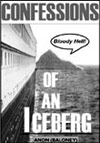 |
There are some books that just don’t fit into any other category. One was Senan Molony’s satire Confessions of an Iceberg. The Icetory of the Hisberg Attacked by the Titanic. The iceberg finally gets to tell the story from his point of view. Humorous fiction as only Molony can tell it. |
 |
From fiction we turn to social commentary with Jeffrey Richards’ book, A Night to Remember; the Definitive Titanic Film. The author attempts to prove that the movie based on Walter Lord’s book remains the best of all movies ever filmed about Titanic. |
Missing in Action.
Two books that were to be released in 2003 did not make it into print. Dr. Austin Murphy’s Practical Financial Economics: A New Science was due out at the end of the year, but didn’t make it. It will probably be showing up sometime in early 2004. This book is one of those anthologies with a Titanic connection. The relevant chapter analyzes the sinking from a financial standpoint and also provides new insights into the financial situation of Titanic’s parent company International Mercantile Marine.
Another book that didn’t make it, and may never see the light of day was John Protasio’s On a Cold April Night: A Tale of the Titanic Disaster. It was to be a work of historical fiction. But the publisher is now out of business and plans for publication have been canceled.
The Not the Titanic Book Section.
Rex T. Jackson’s book The Sultana Saga: The Titanic of the Mississippi was one such that made it onto store shelves in 2003. The Sultana was a riverboat whose boilers exploded causing massive lost of life from shrapnel and the resulting fire. This is another book with Titanic in the title which is primarily about a different disaster alltogether, in this case the Sultana tragedy. It does, however, contain eye witness accounts from the Titanic sinking, as well as other comparisons throughout the book.
A Sneak Peak at 2004.
From the prepublication information publishers are releasing, there will be some potentially terrific new books released in 2004. Here are just a few quick highlights:
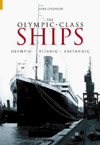 |
By far the most interesting nonfiction title on the horizon is Mark Chirnside’s history of the Olympic class ships, called, appropriately enough, The Olympic Class Ships: Olympic, Titanic, Britannic. This work has been grinding through the publication process for what seems like forever, but it now looks pretty solid for an April release. Chirnside’s book is definitely one of the most eagerly anticipated titles of the year. No pressure Mark! |
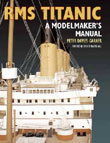 |
Books about modeling the Titanic are few and far between. Author Peter Davies-Garner’s book RMS Titanic, A Modeler’s Guide has the potential to rectify this deficiency in style. It promises to be the ultimate modeler's guide, massively illustrated and even complete with the author’s detailed set of plans. This one is tentatively due out in June. |
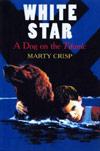 |
Several more books for young readers are on the way, but the most original looks to be Marty Crisp’s book White Star. It tells the story of a fictional Irish Setter who joins the dozen or so dogs that really were on Titanic. It is supposed to be released in April. |
What else will the new year bring? What other books are quietly winding their way towards publication? Only time will tell, but if you hear rumor of a book, please do drop me a line and let me know.
As always, I will update the Upcoming Book News page of the web site whenever I hear any information about forthcoming titles. Keep an eye on the New Book Alerts page as well, as I will post notices there when books are available for purchase.
|
|
|
|